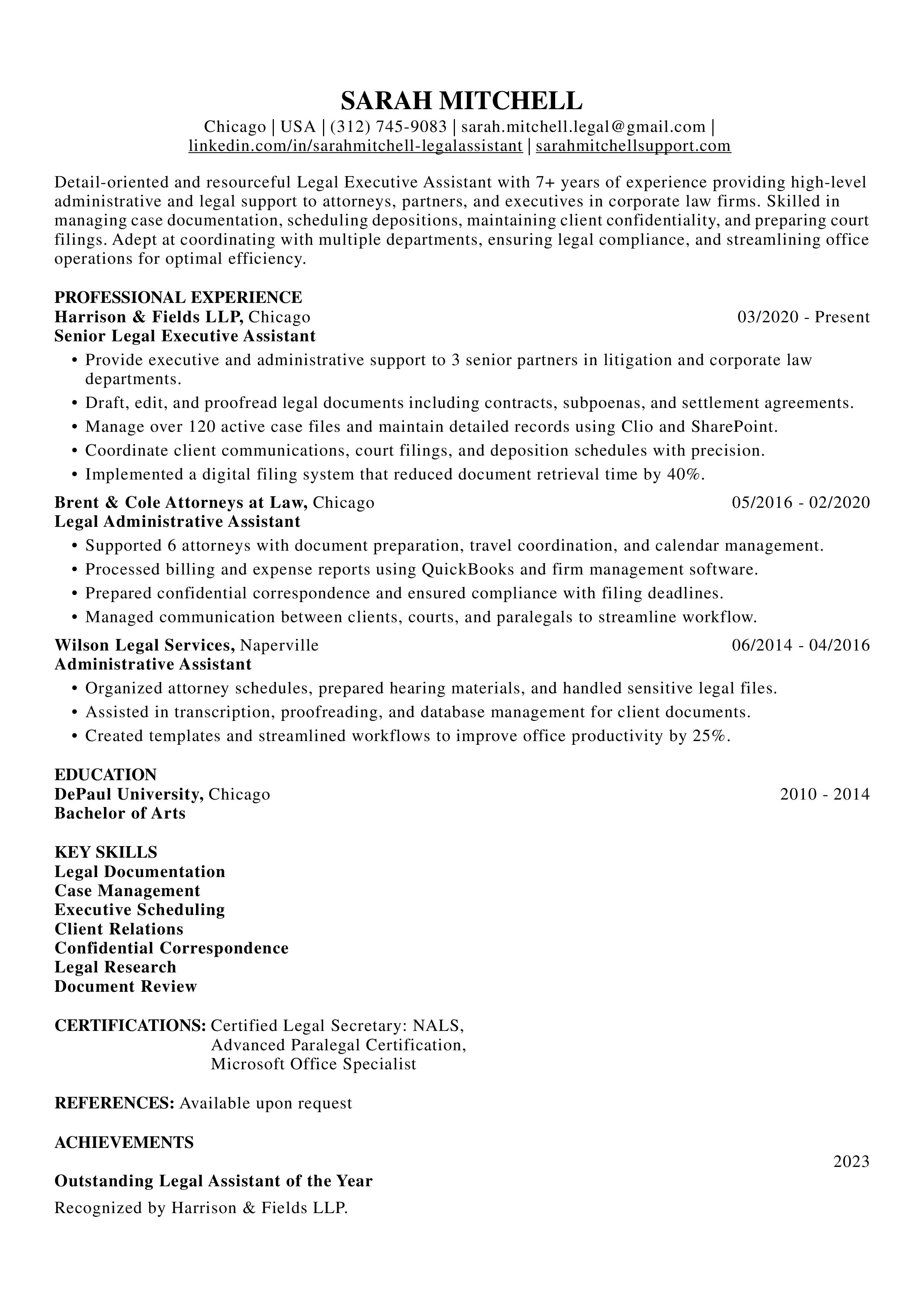Harvard Resume Template: A Timeless Format for Academic and Professional Success
Trust Score: 4.8
359 reviews

Table of Contents
Introduction: What Makes the Harvard Resume Template Stand Out
When it comes to making a strong first impression in the job market, clarity and professionalism matter. The Harvard Resume Template is known for its clean, structured, and no-nonsense layout that highlights skills, education, and achievements without unnecessary design elements. This format is widely used not only at Harvard but across top universities and corporate hiring channels because it is simple to read and easy to scan, allowing recruiters to quickly assess key qualifications.
Who This Template Is Best For
 Students and recent graduates who need to present academic achievements, internships, and project work clearly.
Students and recent graduates who need to present academic achievements, internships, and project work clearly. Professionals seeking a polished and formal resume layout suitable for corporate hiring.
Professionals seeking a polished and formal resume layout suitable for corporate hiring. Academic or research applicants who need a systematic way to present publications, research experience, and leadership roles.
Academic or research applicants who need a systematic way to present publications, research experience, and leadership roles.
What This Blog Will Cover
In this blog, you will learn:
 How the Harvard resume format is structured
How the Harvard resume format is structured The key formatting rules that make it clean and ATS-friendly
The key formatting rules that make it clean and ATS-friendly Examples of strong impact-based bullet points
Examples of strong impact-based bullet points Common mistakes to avoid when using this format
Common mistakes to avoid when using this format
Understanding the Harvard Resume Format
The Harvard resume format is built on the idea that a resume should be clear, concise, and focused on achievements rather than job duties. Unlike visually decorative resume templates that rely on colors, icons, or graphics, the Harvard format keeps the layout simple and text-based. This ensures that your skills, experience, and accomplishments stand out without distractions.
The Core Purpose of This Resume Style
The main goal of the Harvard resume format is not just to list what you have done, but to show the results of your work. It helps you demonstrate:
 What you contributed to each role
What you contributed to each role How your actions made a measurable impact
How your actions made a measurable impact Why your experience is relevant to the role you are applying for
Why your experience is relevant to the role you are applying for
This format directs attention to your qualifications, outcomes, and growth rather than visual presentation.
Key Characteristics of the Harvard Resume Format
 One-page layout for most candidates
One-page layout for most candidates Clean and consistent section spacing
Clean and consistent section spacing Standard professional fonts (such as Times New Roman, Calibri, Georgia, or Garamond)
Standard professional fonts (such as Times New Roman, Calibri, Georgia, or Garamond) Bullet points instead of large paragraphs
Bullet points instead of large paragraphs Clear separation of sections using headings and spacing rather than graphics
Clear separation of sections using headings and spacing rather than graphics Minimal use of color or stylistic elements
Minimal use of color or stylistic elements
This type of formatting makes it easy for both human recruiters and Applicant Tracking Systems (ATS) to read and interpret your resume without errors.
Why Recruiters and Hiring Managers Prefer This Format
Most hiring managers review a resume for 7–12 seconds before deciding whether to read further. The Harvard resume format helps your resume pass that initial scan by:
 Making your most important qualifications visible immediately
Making your most important qualifications visible immediately Using short, strong bullet points instead of blocks of text
Using short, strong bullet points instead of blocks of text Presenting experience in reverse chronological order, making your most recent work stand out first
Presenting experience in reverse chronological order, making your most recent work stand out first Avoiding design choices that slow down readability
Avoiding design choices that slow down readability
Recruiters are able to identify your skills and experience quickly, which improves your chances of moving forward in the selection process.
Who Should Use the Harvard Resume Template
This resume format is especially beneficial for:
 Students and fresh graduates building their professional profile
Students and fresh graduates building their professional profile Individuals applying for internships or entry-level roles
Individuals applying for internships or entry-level roles Graduate school, fellowship, or research applicants who need a structured academic layout
Graduate school, fellowship, or research applicants who need a structured academic layout Professionals working in formal or corporate industries (such as consulting, finance, government, law, administration)
Professionals working in formal or corporate industries (such as consulting, finance, government, law, administration)
If you want a resume that appears serious, credible, and well-organized, the Harvard resume format is an excellent choice.
How to Structure Your Free Harvard Resume
A Harvard-style resume focuses on clarity, strong organization, and evidence-based achievements. Each section is designed to highlight what you bring to the table, rather than simply listing duties or roles. By structuring your resume strategically, you can communicate your strengths quickly and persuasively.
Let’s break down each section and understand how to write it effectively.
Craft a Compelling Resume Summary
What this section does
Your resume summary is the first impression. It should communicate who you are, what you’ve accomplished, and why you’re a strong candidate — all in 2–4 lines.
What to include
 Number of years of relevant experience (if applicable)
Number of years of relevant experience (if applicable) Most important skills related to the job
Most important skills related to the job Major accomplishments, awards, or outcomes that show impact
Major accomplishments, awards, or outcomes that show impact A career direction or goal (optional, but helpful)
A career direction or goal (optional, but helpful)
How long should a CV be?
Example for an experienced applicant
Example for new graduates or students (useful when experience is limited)
Highlight Your Education
Since Harvard resumes are often used by students and early-career candidates, your academic background is a core strength.
What to include
 School name and campus location
School name and campus location Degree and concentration
Degree and concentration Graduation date (or expected graduation date)
Graduation date (or expected graduation date) GPA (include only if strong — above 3.5 is a common benchmark)
GPA (include only if strong — above 3.5 is a common benchmark) Honors, scholarships, fellowships
Honors, scholarships, fellowships Relevant coursework, thesis, or capstone (only if meaningful)
Relevant coursework, thesis, or capstone (only if meaningful) Study abroad or exchange programs
Study abroad or exchange programs
Example format
HARVARD UNIVERSITY
A.B. in Bioengineering, GPA 3.89
Dean’s List | NSF Undergraduate Research Fellowship | Pre-Medical Society
Cambridge, MA — May 2023
Study Abroad — Revolution in Biomedicine
Imperial College London, UK — June–July 2022
Showcase Your Experience
Your experience section should follow reverse chronological order, starting with your most recent position. Every bullet should communicate impact, not just responsibility.
How to write bullets (formula)
Example entry
Legal Intern | Harrison & Klein LLP
Cambridge, MA | May 2023 – August 2023
- Drafted and reviewed 30+ legal documents and pleadings with zero errors flagged in partner review.
- Assisted attorneys in mediation and settlement negotiations, helping clients avoid an average of $50,000 in litigation costs.
- Conducted intake interviews with 15+ prospective clients, improving client onboarding efficiency by 20%.
Special note
Feature Relevant Skills
Purpose
Your skills section quickly signals whether you match the role’s technical and professional requirements.
How to organize
Group skills into categories so they are easier to scan.
Example layout
Technical Skills: Data Visualization, R, Python (pandas), SQL
Languages: English (Fluent), Spanish (Professional), French (Basic)
Soft Skills: Team Collaboration, Public Speaking, Stakeholder Communication
Tip
Add Meaningful Optional Sections
Optional sections help differentiate you from other applicants.
Choose from:
 Research Experience
Research Experience Leadership Experience
Leadership Experience Publications
Publications Conference Presentations
Conference Presentations Projects
Projects Volunteer Experience
Volunteer Experience Certifications & Training
Certifications & Training
Example
Editor-in-Chief | The Harvard Crimson
Cambridge, MA | January 2023 – December 2023
- Led a 50+ member editorial team producing 250+ weekly articles reaching 1M+ monthly readers.
- Increased engagement by 35% through strategic newsroom restructuring and multimedia editorial planning.
- Organized 5+ high-profile journalism forums featuring national media leaders.
Want to Make This Sample? Use thia Instaresume Free Harvard Template
Instead of formatting from scratch, you can use our pre-designed Harvard resume template — clean, ATS-friendly, and structured exactly like this guide.
👉 Start Editing Your Harvard-Style Resume Now (Free)
Instaresume Harvard Resume Builder
Formatting Rules to Follow (So It Looks Truly Harvard-Style)
The visual presentation of your resume matters just as much as the content. A Harvard-style resume is known for its clarity, simplicity, and professional layout. The goal is to make your resume as easy to read and evaluate as possible — without decorative elements or unnecessary design features.
Below are formatting guidelines that ensure your resume appears polished and recruiter friendly.
Recommended Fonts and Sizes
Core principle
Choose a clean, professional, serif or sans-serif font that does not distract from the text. Harvard resumes favor traditional and reader-friendly fonts.
Suggested fonts
 Times New Roman (classic and traditional)
Times New Roman (classic and traditional) Garamond (professional and elegant)
Garamond (professional and elegant) Georgia (serif with excellent readability)
Georgia (serif with excellent readability) Calibri (modern and polished)
Calibri (modern and polished) Arial (simple and clean)
Arial (simple and clean)
Recommended font sizes
 Name: 14–16 pt
Name: 14–16 pt Section headings: 11–12 pt
Section headings: 11–12 pt Body text: 10–11 pt
Body text: 10–11 pt Avoid anything below 10 pt — it becomes difficult to read and may fail on ATS parsing.
Avoid anything below 10 pt — it becomes difficult to read and may fail on ATS parsing.
Tip
Use only one font throughout your resume to maintain consistency.
Keep It to One Page (In Most Cases)
One-page is ideal when:
 You are a student
You are a student You are a new graduate
You are a new graduate You have fewer than 6–8 years of experience
You have fewer than 6–8 years of experience
When a two-page resume is acceptable:
 You have senior-level experience
You have senior-level experience You have multiple publications, research projects, or teaching roles
You have multiple publications, research projects, or teaching roles You are applying to academic or research-focused positions
You are applying to academic or research-focused positions
If unsure, default to one page — recruiters spend 7–12 seconds on first glance.
Bullet-Point Writing Style
Why bullets are essential
Bullets help communicate achievements efficiently. Dense paragraphs are harder to read and often get skipped.
How to write bullets effectively
Start every bullet with a strong action verb:
 Analyzed
Analyzed Designed
Designed Led
Led Implemented
Implemented Coordinated
Coordinated Delivered
Delivered
Structure each bullet
Action verb + task + method + result (if measurable)
Example:
 Conducted sentiment analysis on 5,000+ survey responses to identify trends that shaped 2024 outreach strategy.
Conducted sentiment analysis on 5,000+ survey responses to identify trends that shaped 2024 outreach strategy.
Keep bullets short (1–2 lines) and avoid filler words like responsible for or helped with.
Spacing, Margins, and Alignment
Margins
Use 0.5" to 1" margins on all sides.
Too small = cluttered.
Too large = wasted space.
Line spacing
 Use consistent single spacing
Use consistent single spacing Leave a small blank line (or 6–8 pt spacing) between sections to give breathing room
Leave a small blank line (or 6–8 pt spacing) between sections to give breathing room
Alignment
 Align all section headings left
Align all section headings left Align dates right, or keep them in a consistent column
Align dates right, or keep them in a consistent column Keep bullet points aligned perfectly — any misalignment looks unprofessional
Keep bullet points aligned perfectly — any misalignment looks unprofessional
Don’t use:
 Text boxes
Text boxes Background colors
Background colors Images or icons
Images or icons Decorative borders
Decorative borders
These often break ATS systems and reduce readability.
Always Save and Send as a PDF
When applying online or via email, submit your resume as a PDF to preserve:
 Formatting
Formatting Spacing
Spacing Alignment
Alignment Line structure
Line structure
Exceptions:
 Some ATS portals specifically request .docx — in that case, upload the Word version.
Some ATS portals specifically request .docx — in that case, upload the Word version.
Save naming example
Riya_Sharma_Resume.pdf
Amit_Verma_ProductAnalyst_Resume.pdf
A neat file name shows professionalism at a glance
How to Write Strong Impactful Bullet Points
The strength of your resume depends heavily on the quality of your bullet points. Instead of describing what you were responsible for, your bullet points should show what you achieved and the impact your contributions made. This is what turns a flat resume into a persuasive one.
Use the Action Verb + Task + Result Formula
Structure
Start each bullet with a clear action verb, followed by the task you performed, and end with the result or outcome.
Formula Breakdown
Action Verb + What You Did + How You Did It + Result (quantified when possible)
This helps employers immediately understand:
 What role you played
What role you played What skills you used
What skills you used What measurable impact you created
What measurable impact you created
Start with a Strong Action Verb
Examples of effective action verbs:
 Analyzed
Analyzed Designed
Designed Coordinated
Coordinated Led
Led Implemented
Implemented Developed
Developed Optimized
Optimized Presented
Presented Researched
Researched Executed
Executed
Avoid weak starters like: helped, assisted, worked on, supported.
Quantify Achievements Wherever Possible
Numbers make your accomplishments concrete and credible.
They answer the unspoken recruiter question: How much? How many? How well?
You can quantify:
 Scope (team size, number of stakeholders)
Scope (team size, number of stakeholders) Scale (number of participants, clients served)
Scale (number of participants, clients served) Efficiency improvements (time saved, cost reduced)
Efficiency improvements (time saved, cost reduced) Performance metrics (growth %, engagement, revenue)
Performance metrics (growth %, engagement, revenue)
Even if you think something can’t be quantified, you can usually add context like frequency, volume, or scale.
Bullet Point Transformations (Before vs. After)
Example 1
✅ Led a 12-member event team to organize a 500+ participant cultural fest, increasing attendance by 30% compared to the previous year.
Example 2
✅ Processed and analyzed weekly data for 200+ customer records, improving reporting accuracy and reducing manual review time by 15%.
Example 3
✅ Created and scheduled social media content for a student-run organization, increasing audience engagement by 42% over three months.
Example 4 (Research-focused)
✅ Conducted controlled lab testing on 3 biomedical prototypes, compiling results into structured reports used to support further grant funding proposals.
Pro Tip: Make Every Bullet Start with the Impact You Want to Highlight
When writing a bullet:
Ask yourself → What changed because of my work?
Then make that the focus of your wording.
Common Resume Mistakes and How to Avoid Them
Resumes often fail not because the candidate lacks experience but because the presentation is unclear or unfocused. A Harvard-style resume emphasizes clarity, relevance, and outcome-driven achievements. Below are the most frequent mistakes applicants make — and how to correct them effectively.
Avoid Large Paragraphs — Use Bullet Points Instead
Large chunks of text make your resume harder to read and reduce the chance of key points being noticed. Recruiters typically scan resumes in 6–10 seconds, so clarity is essential.
What to Do
 Keep bullet points short and impactful.
Keep bullet points short and impactful. Use one line per accomplishment where possible.
Use one line per accomplishment where possible. Begin with a strong action verb each time.
Begin with a strong action verb each time.
Example
❌ Wrote a long description of responsibilities in paragraph form.
✅ Broke job experience into clear, measurable bullet points.
Don’t Just List Responsibilities — Highlight Achievements
A resume is not a job description. Recruiters already know what your job title means. What they care about is how well you performed.
What to Do
 Focus on accomplishments, not tasks.
Focus on accomplishments, not tasks. Use the Action Verb + Task + Result structure.
Use the Action Verb + Task + Result structure.
Example
❌ Responsible for handling customer inquiries.
✅ Resolved 50+ customer tickets weekly with a 92% satisfaction rating.
Remove Irrelevant or Outdated Information
You don’t need to include everything you’ve ever done. Harvard-style resumes value relevance over volume.
What to Avoid
 School achievements older than 4 years (unless academic resume).
School achievements older than 4 years (unless academic resume). Skills that everyone is expected to have (e.g., “MS Word,” “Internet Browsing”).
Skills that everyone is expected to have (e.g., “MS Word,” “Internet Browsing”). Personal details like age, photo, father’s name, complete address, etc.
Personal details like age, photo, father’s name, complete address, etc.
What to Include Instead
 Recent, impactful academic/work achievements.
Recent, impactful academic/work achievements. Skills that match the job description.
Skills that match the job description. Leadership roles, research work, internships, measurable results.
Leadership roles, research work, internships, measurable results.
Avoid Colors, Graphics, Icons, Tables, and Photos
Many creative resumes look nice but fail ATS scanning. Harvard format is intentionally minimal and text-based so it passes every Applicant Tracking System.
Best Practice
 Stick to black text on white background.
Stick to black text on white background. Use simple bullet symbols (• , – or •).
Use simple bullet symbols (• , – or •). Avoid icons, text boxes, and multi-column structures.
Avoid icons, text boxes, and multi-column structures.
Why?
ATS systems read text line by line. Anything visual can cause information loss or rejection.
Always Customize Your Resume for Each Job
A single generic resume lowers your selection chances. Employers want to see alignment with their role.
What to Do
 Pick keywords from the job posting.
Pick keywords from the job posting. Adjust bullet points to match required skills.
Adjust bullet points to match required skills. Re-position or emphasize relevant experience.
Re-position or emphasize relevant experience.
Example
If applying for a Marketing role:
 Highlight campaign results, brand activities, communication skills.
Highlight campaign results, brand activities, communication skills.
If applying for a Research or Academic role:
 Highlight publications, presentations, research methodology, academic achievements.
Highlight publications, presentations, research methodology, academic achievements.
Conclusion: Why the Harvard Resume Format Works
A Harvard-style resume is simple, clear, and strategically structured to highlight what truly matters. Its strength lies in focusing on achievements, impact, and readability, making it easier for recruiters and hiring managers to quickly understand your professional value.
Why This Format Is Effective
 It eliminates unnecessary design elements and keeps the focus on content.
It eliminates unnecessary design elements and keeps the focus on content. It uses consistent spacing, clean typography, and well-organized sections.
It uses consistent spacing, clean typography, and well-organized sections. It presents accomplishments in a way that proves capability, not just responsibilities.
It presents accomplishments in a way that proves capability, not just responsibilities. It is universally accepted across industries—corporate, academic, research, consulting, and public sector.
It is universally accepted across industries—corporate, academic, research, consulting, and public sector.
This resume style demonstrates maturity, confidence, and professionalism. It communicates that you understand how recruitment works and that you respect the recruiter's time and expectations.
Ready to Create Your Harvard-Style Resume?
A good resume shouldn’t take hours. With the right structure and guidance, it becomes a simple, step-by-step process.
Call to Action
Start building your Harvard Resume today with Instaresume’s Free Resume Builder.
Professional. Clean. ATS-friendly. Done in minutes.








